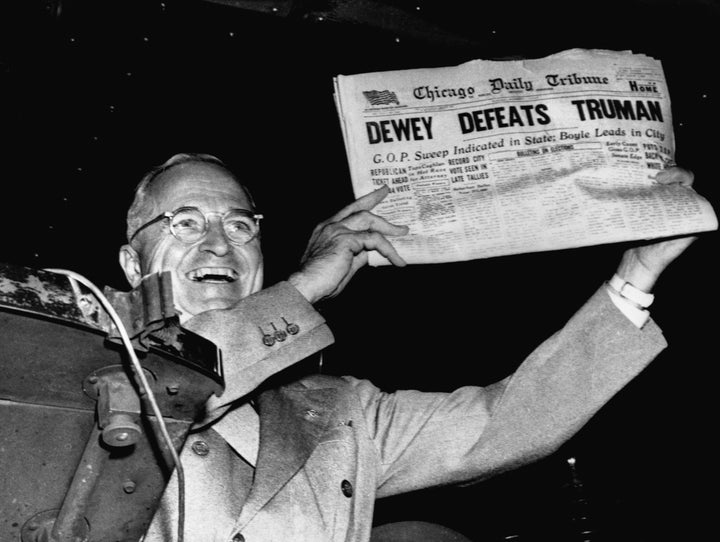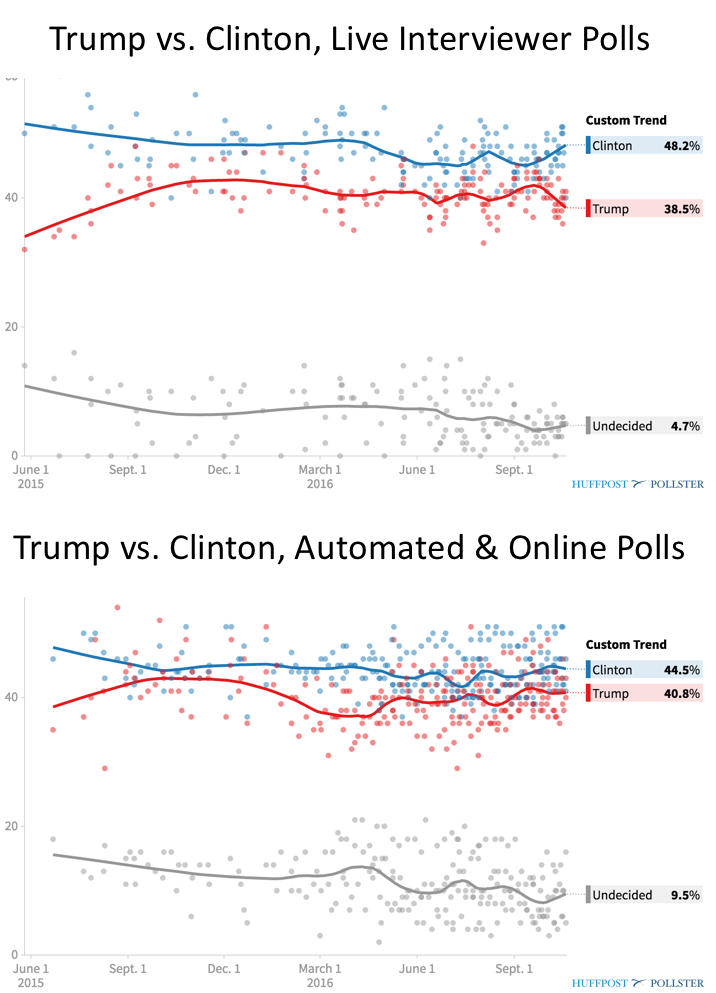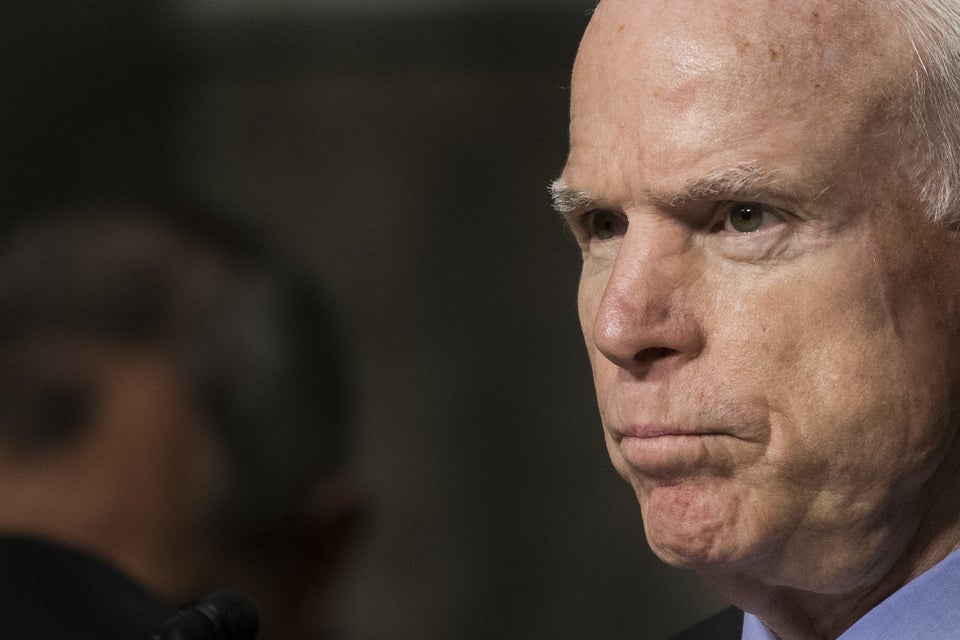
If anyone thinks Donald Trump is doing well or even close to winning this election, they’re badly mistaken. Only the GOP presidential nominee himself and his most ardent supporters believe that. Even his own campaign manager is subtly distancing herself from the candidate.
Despite often-crazy election news cycles, polling numbers have been pretty boring in the past couple of months. Trump has never been ahead. Yet the narrative that polls could be wrong persists among liberals and conservatives: Trump supporters think polls are missing a “silent majority,” who are refusing to answer polls but will vote for Trump on Election Day. Others believe “shy” Trump voters won’t admit their voting preference to others. Liberals point to “what if” nightmare scenarios for reasons to doubt the numbers.
So let’s check out the claims from both sides. The polling industry certainly has its challenges, and polls have been wrong from time to time. First, some context: Democratic candidate Hillary Clinton now leads by a little more than 7 points in the HuffPost Pollster aggregate of national election polls in a 2-way contest with Trump. She’s just under 7 points ahead when third party candidates are included.
If Trump wins the popular vote on Nov. 8, it would be a polling miss unlike we’ve ever seen before in a general presidential election. Even the “Dewey Defeats Truman” debacle in 1948, in which news organizations incorrectly called the presidential election for Thomas Dewey over Harry Truman based on polling data, was only about a 5-point polling miss. And that miss was mostly due to the fact that the few pollsters that existed in 1948 stopped polling a few weeks before the election.
That would never happen now. Polls will be released up until the day before the election, and possibly on Election Day itself. And we’ve learned a few things about polling in the 68 years since then. It’s true that the field is in flux right now due to technological and societal changes, but it’s unlikely we’ll see an unprecedented polling failure.
Are polls missing Trump voters?
Trump supporters are really big on the idea that polls aren’t adequately capturing support for the GOP nominee. To be fair, we won’t know for sure if claims of there being a “silent majority” or “shy” Trump voters is happening until votes are cast and counted, but there’s evidence that neither phenomenon will be big enough to propel him to victory.
The simplest way to look for a “shy” or “silent” effect is to look at polls by mode. Some polls are conducted using live interviewers, whereby respondents have to actually reveal who they are backing to another person. But some polls are conducted online or with automated phone techniques, so the respondent is answering privately. If anyone is embarrassed to reveal their vote choice to another person (perhaps because the candidate promotes racist and misogynistic ideas that are socially undesirable), then the Trump vote share should increase in the online and automated surveys when compared to the telephone polls.
That pattern was observed in the primary polls, but it hasn’t been as prominent in general election polling. Among live telephone pollsters in the HuffPost Pollster chart, Clinton leads Trump 48.2 to 38.5. Among internet and automated phone polls the former secretary of state’s lead shrinks to 44.5 over Trump’s 40.8. That’s a substantial difference ― Clinton +9.7 percent versus +3.7.

But note that it doesn’t change the outcome. And take a look at which number changes more: Trump only gains 2 points in online and automated polls, but Clinton loses nearly 4 points. Undecideds comprise 4.7 percent in the live interviewer polls, but they jump to 9.5 percent in online and automated polls. There’s definitely a difference, but it’s not shy Trump voters causing it ― it’s that online and automated polls often don’t push undecided voters to make a decision between candidates when live interviewer polls do.
And if that isn’t enough evidence for you, a “list experiment” designed to reveal shy Trump supporters also finds the claim without support. Yale University professor Alexander Coppock reports that a poll testing direct support for Trump (“for whom would you vote?”) against an indirect test produced statistically similar results.
The “list experiment” indirect test randomly assigned poll respondents to two groups. One group was given a list of three non-controversial things and asked how many they would do. The other group was given the same list, but added “vote for Donald Trump” as a fourth item and asked how many they would do. The difference between the average number of things respondents would do in each group is the support for Trump ― but since no one had to actually say they’d vote for the GOP nominee, the potential for social desirability bias is dramatically reduced. This method showed 31.5 percent support for him, and the direct ballot question showed 32.5 percent support ― no sign of a “shy” Trump voter effect.
“What if a case like Brexit happens?”
First of all, the vote for a British exit from the European Union was not a big polling “miss.” Polls showed “remain” in the EU and “leave” the European bloc essentially tied among the British electorate. The shock of “leave” winning was caused by betting markets and everyone’s assumption that “remain” would win.
But it’s true that polls have a major challenge to overcome in obtaining a representative sample of voters. Technology has changed ― pollsters have to call cell phones in order to get a representative sample by telephone, and some pollsters have developed online surveying methods that approximate representative samples. Response rates have dropped ― finding people willing to take polls is more difficult than ever. Determining who is likely to vote on Election Day is a big challenge. And even under the best of circumstances, polls can be off due to several types of error throughout the process of conducting a survey.
Despite all that, there are two big reasons to think this year’s presidential polls are performing fairly well: (1) the consistency of the polls, and (2) the magnitude of Clinton’s lead.
On the national level, polls have been very consistent in indicating that Clinton is the frontrunner in the presidential race. Only 2 of the 40 national Trump versus Clinton polls over the past month in the HuffPost Pollster database have shown Trump leading ― and we’d expect about that many to be wrong overall simply because of errors in the sampling and survey processes.
There is more variance in poll results some of the states. Clinton and Trump are duking it out for the polling lead in Ohio, for example. But according to the HuffPost presidential forecast model, Clinton’s advantage in the states she needs to win the Electoral College is consistent and strong ― she doesn’t need any tossup states in order to win.
And then we’re back to the size of Clinton’s lead, both in the Electoral College projections and in national polls. She’s ahead by 7 points in the national polling aggregate and 144 electoral votes in the forecast model.
Recent polling misses, perhaps most notably the United Kingdom parliamentary election in May 2015, have been a matter of 3-5 points. That’s not enough to sway this election in Trump’s favor. The poll misfire in Michigan’s Democratic primary was larger, but it also had fewer polls, fewer pollsters and a highly unpredictable primary electorate.
No presidential candidate has ever overcome the polling deficit that Trump faces, and “the polls are wrong” argument assumes that hundreds of polls systematically miss by an unprecedented margin. There’s strong evidence that neither will happen.
Editor’s note: Donald Trump regularly incites political violence and is a serial liar, rampant xenophobe, racist, misogynist and birther who has repeatedly pledged to ban all Muslims ― 1.6 billion members of an entire religion ― from entering the U.S.

